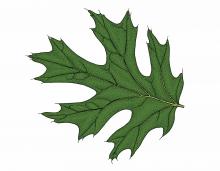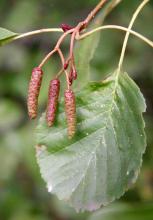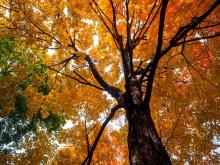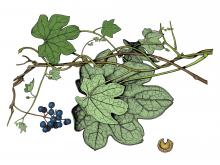Trees, Shrubs and Woody Vines
Media

Species Types
Scientific Name
Quercus velutina
Description
Black oak grows throughout Missouri, in upland woods, on glades, and along borders of woods and fields. It and scarlet oak were the primary colonizers of Ozark pinelands when the native pines were cleared in the early 1900s.
Media

Species Types
Scientific Name
Quercus shumardii
Description
Shumard oak is worth knowing: it can rise to 100 feet in height and gain a trunk diameter of 5 feet, with wide-spreading, muscular boughs.
Media

Species Types
Scientific Name
Quercus palustris
Description
Pin oak is one of the easiest trees to recognize by its shape alone: It has a tall, straight trunk, an overall pyramidal or conical shape and, most notably, the branches on the lower third of the tree angle downward.
Media

Species Types
Scientific Name
Quercus texana
Description
In Missouri, Nuttall's oak grows naturally only in Bootheel. With its limited range, and with steady destruction of its habitat, it has become rare and imperiled within our borders.
Media

Species Types
Scientific Name
Quercus rubra
Description
Northern red oak is a favorite for planting in streets and parks and is one of the most widespread and commercially important of the oaks.
Media

Species Types
Scientific Name
Alnus glutinosa
Description
Native to Europe and Asia, European, or black alder is planted widely as an ornamental. In some parts of the United States and elsewhere in the world, this species becomes weedy, even invasive. In Missouri, you are most likely to encounter it in landscaped areas, and not in the wild.
Media

Species Types
Scientific Name
Toxicodendron radicans
Description
Poison ivy is a toxic plant that contains an oil in all its parts that, if you come into contact with it, can cause an intense skin reaction. Learn to recognize it, and sidestep it on your outings.
Media

Species Types
Scientific Name
Physocarpus opulifolius
Description
An attractive shrub with wide-spreading, graceful, recurved branches and bark peeling off in conspicuous thin strips, ninebark is found throughout southern and eastern Missouri on gravel bars, rocky stream banks, and bluffs along streams. It's very popular as a native landscaping shrub, too.
Media

Species Types
Scientific Name
Acer spp.
Description
Missouri has five species of maples that are either native or naturalized, plus several that are known only in cultivation. Maples are important members of native ecosystems. They also provide stunning fall color, welcome shade in summer, commercially important lumber, and sap for syrup.
Media

Species Types
Scientific Name
Menispermum canadense
Description
Common moonseed is a rather slender, twining vine that climbs or sprawls. It occurs nearly statewide. It bears clusters of bluish-black fruits. The seeds are flattened, with a raised edge shaped like a crescent moon.
See Also
About Trees, Shrubs and Woody Vines in Missouri
There are no sharp dividing lines between trees, shrubs, and woody vines, or even between woody and nonwoody plants. “Wood” is a type of tissue made of cellulose and lignin that many plants develop as they mature — whether they are “woody” or not. Trees are woody plants over 13 feet tall with a single trunk. Shrubs are less than 13 feet tall, with multiple stems. Vines require support or else sprawl over the ground.





















